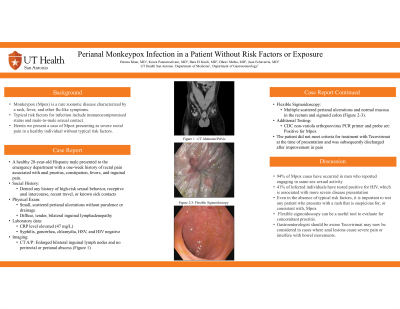Monday Poster Session
Category: Colon
P1640 - Perianal Mpox Infection in a Patient Without Risk Factors or Exposure
Monday, October 23, 2023
10:30 AM - 4:15 PM PT
Location: Exhibit Hall

Has Audio

Hamza Khan, MD
UT Health San Antonio
San Antonio, TX
Presenting Author(s)
Award: Presidential Poster Award
Hamza Khan, MD1, Kavea Panneerselvam, MD1, Bara El Kurdi, MD1, Benjamin Heriford, DO2, Jonathan Selzman, DO2, Umar Siddiqui, DO3, Dakota Bigham, MD3, Aliya Sharif, MD1, Dhruv Mehta, MD1, Juan Echavarria, MD2
1UT Health San Antonio, San Antonio, TX; 2University of Texas Health Science Center at San Antonio, San Antonio, TX; 3University of Texas Health Science Center-San Antonio, San Antonio, TX
Introduction: Monkeypox (Mpox) is a rare zoonotic disease characterized by a rash, fever, and other flu-like symptoms. It can range from a mild, self-limiting disease to a severe, life-threatening illness. Typical risk factors for infection include immunocompromised status and male-to-male sexual contact. In this case report, we describe a unique case of Mpox infection presenting as severe rectal pain in an otherwise healthy individual without typical risk factors for infection.
Case Description/Methods: A healthy 28-year-old Hispanic male presented to the emergency department with a one week history of rectal pain associated with anal pruritus, constipation, fevers, and inguinal pain. The patient denied any history of high-risk sexual behavior, receptive anal intercourse, recent travel, or known sick contacts. Physical examination revealed small, scattered perianal ulcerations without purulence or drainage, and diffuse, tender, bilateral inguinal lymphadenopathy. Laboratory values revealed an elevated CRP level (47 mg/L) and normal white blood cell count. Abdominal and pelvic CT scans showed enlarged bilateral inguinal lymph nodes and ruled out perirectal or perianal abscess (Figure 1). Flexible sigmoidoscopy revealed multiple scattered perianal ulcerations and normal mucosa in the rectum and sigmoid colon (Figure 2-3). Testing for syphilis, gonorrhea, chlamydia, HSV, and HIV was negative. Through the utilization of the Center for Disease Control (CDC) non-variola orthopoxvirus PCR primer and probe set, Mpox was confirmed as the cause of the patient's perianal ulcerations. The patient did not meet criteria for treatment with Tecovirimat at the time of presentation and was subsequently discharged after improvement in pain.
Discussion: The CDC reports that the majority of Mpox cases (94%) have occurred in men who reported engaging in same-sex sexual activity prior to the onset of symptoms. Additionally, 41% of infected individuals have tested positive for HIV, which is associated with more severe disease presentations. However, even in the absence of typical risk factors, it is important to test any patient who presents with a rash that is suspicious for, or consistent with, Mpox. Flexible sigmoidoscopy can be a useful tool to evaluate for concomitant proctitis. As per the CDC, Tecovirimat may now be considered in cases where anal lesions cause severe pain or interfere with bowel movements.

Disclosures:
Hamza Khan, MD1, Kavea Panneerselvam, MD1, Bara El Kurdi, MD1, Benjamin Heriford, DO2, Jonathan Selzman, DO2, Umar Siddiqui, DO3, Dakota Bigham, MD3, Aliya Sharif, MD1, Dhruv Mehta, MD1, Juan Echavarria, MD2. P1640 - Perianal Mpox Infection in a Patient Without Risk Factors or Exposure, ACG 2023 Annual Scientific Meeting Abstracts. Vancouver, BC, Canada: American College of Gastroenterology.
Hamza Khan, MD1, Kavea Panneerselvam, MD1, Bara El Kurdi, MD1, Benjamin Heriford, DO2, Jonathan Selzman, DO2, Umar Siddiqui, DO3, Dakota Bigham, MD3, Aliya Sharif, MD1, Dhruv Mehta, MD1, Juan Echavarria, MD2
1UT Health San Antonio, San Antonio, TX; 2University of Texas Health Science Center at San Antonio, San Antonio, TX; 3University of Texas Health Science Center-San Antonio, San Antonio, TX
Introduction: Monkeypox (Mpox) is a rare zoonotic disease characterized by a rash, fever, and other flu-like symptoms. It can range from a mild, self-limiting disease to a severe, life-threatening illness. Typical risk factors for infection include immunocompromised status and male-to-male sexual contact. In this case report, we describe a unique case of Mpox infection presenting as severe rectal pain in an otherwise healthy individual without typical risk factors for infection.
Case Description/Methods: A healthy 28-year-old Hispanic male presented to the emergency department with a one week history of rectal pain associated with anal pruritus, constipation, fevers, and inguinal pain. The patient denied any history of high-risk sexual behavior, receptive anal intercourse, recent travel, or known sick contacts. Physical examination revealed small, scattered perianal ulcerations without purulence or drainage, and diffuse, tender, bilateral inguinal lymphadenopathy. Laboratory values revealed an elevated CRP level (47 mg/L) and normal white blood cell count. Abdominal and pelvic CT scans showed enlarged bilateral inguinal lymph nodes and ruled out perirectal or perianal abscess (Figure 1). Flexible sigmoidoscopy revealed multiple scattered perianal ulcerations and normal mucosa in the rectum and sigmoid colon (Figure 2-3). Testing for syphilis, gonorrhea, chlamydia, HSV, and HIV was negative. Through the utilization of the Center for Disease Control (CDC) non-variola orthopoxvirus PCR primer and probe set, Mpox was confirmed as the cause of the patient's perianal ulcerations. The patient did not meet criteria for treatment with Tecovirimat at the time of presentation and was subsequently discharged after improvement in pain.
Discussion: The CDC reports that the majority of Mpox cases (94%) have occurred in men who reported engaging in same-sex sexual activity prior to the onset of symptoms. Additionally, 41% of infected individuals have tested positive for HIV, which is associated with more severe disease presentations. However, even in the absence of typical risk factors, it is important to test any patient who presents with a rash that is suspicious for, or consistent with, Mpox. Flexible sigmoidoscopy can be a useful tool to evaluate for concomitant proctitis. As per the CDC, Tecovirimat may now be considered in cases where anal lesions cause severe pain or interfere with bowel movements.

Figure: Figure 1: CT Abdomen/Pelvis with bilateral inguinal lymphadenopathy. Figure 2: Perianal ulcerations. Figure 3: Normal rectum.
Disclosures:
Hamza Khan indicated no relevant financial relationships.
Kavea Panneerselvam indicated no relevant financial relationships.
Bara El Kurdi indicated no relevant financial relationships.
Benjamin Heriford indicated no relevant financial relationships.
Jonathan Selzman indicated no relevant financial relationships.
Umar Siddiqui indicated no relevant financial relationships.
Dakota Bigham indicated no relevant financial relationships.
Aliya Sharif indicated no relevant financial relationships.
Dhruv Mehta indicated no relevant financial relationships.
Juan Echavarria indicated no relevant financial relationships.
Hamza Khan, MD1, Kavea Panneerselvam, MD1, Bara El Kurdi, MD1, Benjamin Heriford, DO2, Jonathan Selzman, DO2, Umar Siddiqui, DO3, Dakota Bigham, MD3, Aliya Sharif, MD1, Dhruv Mehta, MD1, Juan Echavarria, MD2. P1640 - Perianal Mpox Infection in a Patient Without Risk Factors or Exposure, ACG 2023 Annual Scientific Meeting Abstracts. Vancouver, BC, Canada: American College of Gastroenterology.

